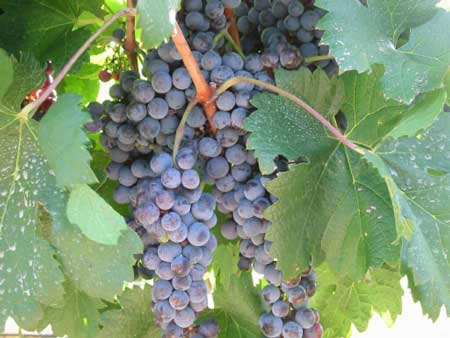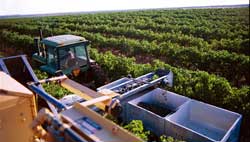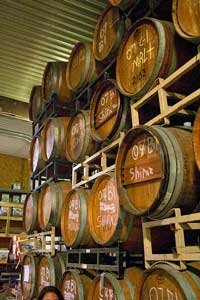
Texas Wine – A Matter of Economics and Quality
Christian Hill of MKE Research was “sweating nails” while standing on the podium as his leadoff presentation started the meeting of the Texas Wine and Grape Growers Association (TWGGA – www.txwines.org) in Austin on Thursday morning. Hill was being besieged by computer troubles. Having been under similar circumstances, I know how hard it is to continue the presentation while trying keep your composure and not look like a proverbial “deer in the headlights”. Despite everyone’s efforts, he was not having much success getting his slides broadcasted for the audience the way he himself could see them on the screen of his PC. However, to his credit, he was a real trouper and continued on with his important message.
Texas by the Numbers
The technical difficulties notwithstanding, Mr. Hill’s message to the annual gathering of Texas viticulteurs was clear, concise and to the point: $1.35 Billion (Yes, billion with a capital “B”). This was the annual economic impact of Texas grape growers and winemakers to their great state of Texas, the fifth largest wine producing state in the USA. An equally impressive aspect revealed by the study was that nearly a million people per year tour Texas wineries and generate about $300 million in sales annually.
To put into perspective the Texas industry’s performance, you need to start from the top – California is ranked number one in size of its wine production with New York, Washington and Oregon following in positions two, three and four. Being number five, Texas bottles about half the wine as does fourth- ranked Oregon. However, the $300 million spent annually by wine tourism in Texas exceeds tourist sales in both Oregon and Washington, both ranked higher in wine production than Texas. What gives in Texas?
The numbers from the MKE Research study suggest something that I believe we already knew….Texans tend to support Texas. Evidence of this is visible in the success of the Texas Department of Agriculture’s GO TEXAN program (http://www.gotexan.org), promoting a wide variety of Texas “L’Agriculture Locale” – Fruits, vegetables, meat, cheese, and now wine.
 The Texas wine industry also has a natural advantage over its western rivals: Texas is a far more populous state than either Washington or Oregon, and the concentration of Texas wineries is in easy access to its population centers (Houston, Dallas, Waco, Austin and San Antonio). By comparison, most wine tourists to Washington and Oregon have to fly in from out of the state. Therefore, local Texas tourists can more easily partake in their own state’s wine experience. Furthermore, our more local tourists can easily bring home purchases of their favorite “juice” by car without needing to hassle with post 9-11 rules for carrying liquids on airplanes. With the present economic situation whereby people are tending to travelling locally rather than to faraway destinations, it appears that the Texas wine industry could be better poised for future growth than other leading wine producing states.
The Texas wine industry also has a natural advantage over its western rivals: Texas is a far more populous state than either Washington or Oregon, and the concentration of Texas wineries is in easy access to its population centers (Houston, Dallas, Waco, Austin and San Antonio). By comparison, most wine tourists to Washington and Oregon have to fly in from out of the state. Therefore, local Texas tourists can more easily partake in their own state’s wine experience. Furthermore, our more local tourists can easily bring home purchases of their favorite “juice” by car without needing to hassle with post 9-11 rules for carrying liquids on airplanes. With the present economic situation whereby people are tending to travelling locally rather than to faraway destinations, it appears that the Texas wine industry could be better poised for future growth than other leading wine producing states.
In the Q&A session that followed this presentation, I asked Mr. Hill what was the biggest barrier to Texas wine producers. He said plainly, “Right now, it is getting enough Texas-grown grapes”. With the rapid growth in the number of Texas wineries from 110 in 2005 to currently about 170 in 2009, many new winemakers simply can’t find enough Texas grapes to meet the demand. To help this situation, the Texas Department of Agriculture is looking for ways to assist in getting more people to grow wine grapes and to support the technical education required to support new Texas growers. They have recently provided a series of “seed-money” grants to help underwrite some of the costs of establishing new Texas vineyards. My personal feeling is that we need existing Texas farmers and ranchers to convert some relatively small 5-10 acre plots of their less productive acreage to wine grapes. These farmers and ranchers are people that simply know how to grow things. I think that it’s in both their family heritage and rich Texas agricultural tradition to utilize the land for sustainable agribusiness.
Quality, Quality and Quality
In the real estate business, people “in the know” always say that there are three important factors for success: Location, Location and Location. In the wine business, there are similarly three factors that boil down to something a little different, but which are equally important. These factors are: Quality, Quality and Quality.
As I talked to several Texas grape growers and winemakers attending the Austin meeting, they all seemed to understand what was required from them at all levels. However, Mike Sipowicz, the Texas Enology Specialist said it best, “Wine consumers generally do not give you second chance. If you don’t provide a quality wine product and experience they are simply not going to return. It is critical that all Texas wineries understand this and it holds true all the way down to the smallest of wineries”. Mike also stressed that it is his job to work with winemakers statewide to help give them the opportunity to elevate their game. He is simply a one man “no winemaker left behind” program for Texas.
Many at the meeting were new winemakers or vineyard owners that have a vision of starting a winery at some point in the near future. Many are already involved in amateur winemaking at the present time to help develop their winemaking skills. Sipowicz made a presentation of basic flaws in wine and simple analytical methods that can be adapted to just about any winery, even the smallest of operations, to identify and qualify problems. He stressed that these problems can be “nipped in the bud” and winemakers can learn to take preventative action before winemaking issues become wine quality issues.
 It was also clear that the meeting attendees acknowledged that quality in the winery is a must, but that quality really needs to be traced all the way back into the vineyard. As one winemaker said, “It is impossible for me to make truly outstanding wines from anything other than the best grapes that Texas has to offer. We have started to work with grape growers around the state to define the quality levels we demand”. This is where Dr. Ed Hellman, Professor of Viticulture, Texas Extension Specialist and the point man for Texas grape growing stepped in. He presented the “Keys to Growing High Quality Grapes”. In reality, it was Dr. Hellman’s “Top Ten List” of things that he and the other Texas viticultural specialists have been stressing for several years now with grape growers down at the regional level. Keep in mind that Texas, being roughly the size of France, has major differences in soils, climate, “critters” and water availability that dictate the local approaches needed to produce quality grapes.
It was also clear that the meeting attendees acknowledged that quality in the winery is a must, but that quality really needs to be traced all the way back into the vineyard. As one winemaker said, “It is impossible for me to make truly outstanding wines from anything other than the best grapes that Texas has to offer. We have started to work with grape growers around the state to define the quality levels we demand”. This is where Dr. Ed Hellman, Professor of Viticulture, Texas Extension Specialist and the point man for Texas grape growing stepped in. He presented the “Keys to Growing High Quality Grapes”. In reality, it was Dr. Hellman’s “Top Ten List” of things that he and the other Texas viticultural specialists have been stressing for several years now with grape growers down at the regional level. Keep in mind that Texas, being roughly the size of France, has major differences in soils, climate, “critters” and water availability that dictate the local approaches needed to produce quality grapes.
Dr. Hellman’s Top Ten List focused on two main themes. First, there are practices that new and existing grape growers need to maintain to establish high quality vineyards in terms of uniformity and balance of production. Grapes are one crop where things do not get better as the size of the crop increases or as the plant exhibits more vigor. Actually, reducing the crop yield works toward increasing quality and intensity of wine grapes and this is something that many farmers looking to develop their land for wine grape production need to keep in mind. This is actually something that all winemakers desire and are willing to pay for.
Secondly, he mentioned aspects that must be managed to preserve grape quality. Surprisingly, more than half of the practices that Dr. Hellman presented in this latter group related to the situations occurring after the grapes were ripe or off the vine. Obviously, after all the hard vineyard work was done, there are a lot of ways that grapes, like other perishable fruits in the marketplace, can be spoiled.
Poised for the Future
The TWGGA meeting was both enlightening and educational for me from the standpoint of my personal understanding of the fundamentals of Texas wine so that I can convey them to many new- found Texas wine consumers. Obviously, all the attention to economic growth is important as the Texas wine industry is still rather young. Yet, it appears to be healthy and, with a few more locally produced grapes, is well poised for the future, even in a very competitive global marketplace. Just as important is the current focus on quality from Texas grape growers and winemakers to result in the best possible wine experience for the growing group of Texas wine consumers.

Be the first to comment